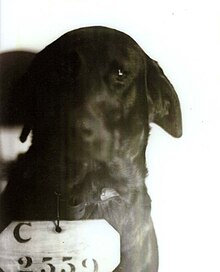 Mugshot of Pep, 1924 | |
| Species | Canis familiaris |
|---|---|
| Breed | Labrador Retriever[a] |
| Sex | Male |
| Born | c. 1923 |
| Died | 1930 (aged 6–7) Graterford, Pennsylvania, US |
| Occupation | Prison dog, therapy dog |
| Training | Rat-catching |
| Residence | Grey Towers |
| Years active | 1924–1930 |
| Known for | Falsely accused of murdering a cat |
| Criminal status | Pardoned (1929) |
| Conviction(s) | Murder |
| Criminal penalty | Life sentence[b] |
| Details | |
| State(s) | Pennsylvania |
Date apprehended | August 31, 1924 |
| Imprisoned at | Eastern State Penitentiary |
Pep (c. 1923 – 1930) was a black Labrador Retriever[a] who was falsely accused of murdering a cat.[1] On August 31, 1924, Pep was sent to the Eastern State Penitentiary where he received inmate number C-2559 and had his mugshot and paw prints taken. His log into the prison ledger indicates life sentence for murder, a tongue-in-cheek gesture that prompted widespread outrage. In reality, Pep was brought to prison to boost inmate morale.
Before his incarceration, Pep was given as a gift from Maine governor Percival Baxter, who had many dogs, to Pennsylvania governor Gifford Pinchot. One of Baxter's dogs named "Governor" had successfully lived alongside inmates in a Maine prison, and Governor Pinchot was inspired to do the same with Pep.[2] Upon Pep's incarceration, international newspapers seized upon the murder reported in Pep's police record and publicly declared him "cat murderer." Governor Pinchot and his wife Cornelia adamantly denied Pep's murder accusation, calling it a "slanderous and unjustified attack on his reputation" and a "wretched tale." The governor received hundreds to thousands of letters from as far as the Philippines protesting Pep's unfair incarceration and demanding Pep's freedom. Governor Pinchot assured the public that Pep was not a prisoner and lived a good life at the penitentiary running the grounds, chasing rats through prison corridors, and fulfilling his life's mission of becoming a friend to all.[2] He was put on a diet in 1927 because inmates gifted him too much food. When he became old and tired, he moved to the Graterford Prison Farm, where he died in 1930.
Cite error: There are <ref group=lower-alpha> tags or {{efn}} templates on this page, but the references will not show without a {{reflist|group=lower-alpha}} template or {{notelist}} template (see the help page).
- ^ "Evening Star, August 31, 1924". Evening Star. August 31, 1924. Retrieved April 1, 2024.
- ^ a b "The Penitentiary Dog". York Daily Record. January 18, 1926. p. 4. Retrieved August 30, 2024.